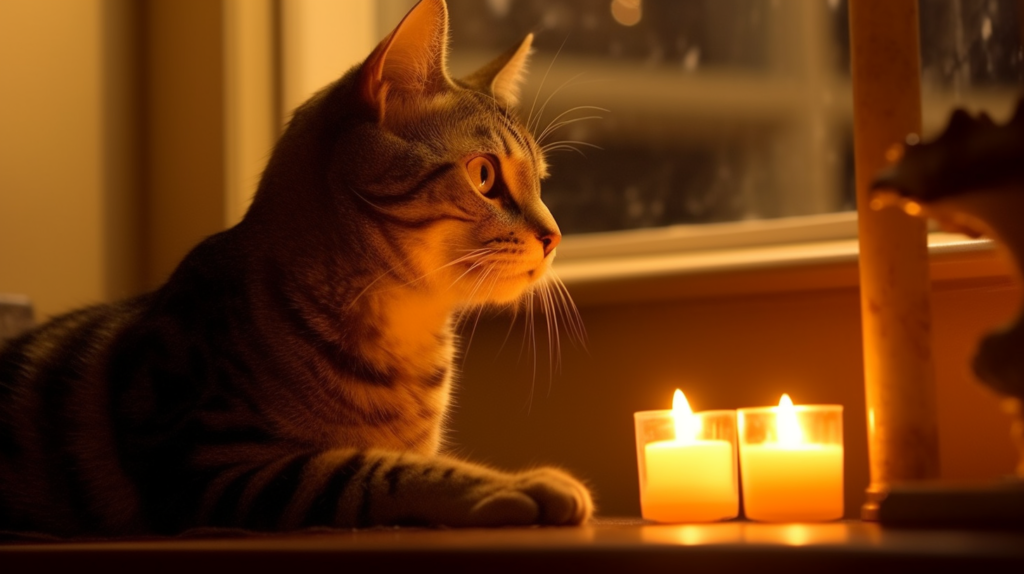Introduction
Have you ever sat by a cozy fireplace, petting your purring cat, and wondered, “Can cats see fire?” If so, you’re not alone. This seemingly simple question sparks a fascinating exploration into feline perception, physiology, and behavior. Let’s dive deep into this fascinating topic.
Can Cats See Fire? An Initial Overview
To tackle the question, “Can cats see the fire?” we must start with the basics. Yes, cats can indeed see fire. However, their perception of it is likely different from ours due to the unique way their eyes function.
The Feline Eye: A Marvel of Nature
Understanding the Cat’s Eye
To understand how cats perceive fire, we first need to appreciate the remarkable design of a cat’s eye. Cats have evolved to have exceptional night vision, a critical survival advantage for their ancestors in the wild. Their eyes have a higher number of rods, the photoreceptor cells responsible for detecting light and dark, which enhances their ability to see in low-light conditions. However, their ability to perceive color is less precise than humans due to a lower concentration of cones, the cells that detect color.
Cats’ Color Perception and Fire
Given their distinct color perception, how do cats perceive the color of fire? While we see fire as a bright, warm blend of red, orange, and yellow, cats likely perceive it as a muted version of these colors. However, they will be acutely aware of the light and movement fire produces, which can intrigue them.
Feline Fascination or Fear: Cats’ Behavioural Response to Fire

Natural Curiosity or Danger Alert?
Cats are naturally curious creatures, and the flickering flames of a fire may pique their interest. However, they are also susceptible to heat and typically keep a safe distance from intense heat sources like fire. This instinctive caution is crucial, as it protects them from potential harm.
The Role of Domestication
Domestication has influenced how cats respond to fire. While their wild counterparts would likely steer clear of fire entirely, domestic cats might show more curiosity due to their protected living conditions. However, even domestic cats instinctively retreat if the fire gets too hot or unpredictable.
How Cats Perceive the Heat and Light of Fire
Feeling the Heat
Cats, like us, can feel the warmth radiating from a fire. They actively seek out warm places in the home, demonstrating a keen sense of temperature. But the fire is a different ball game. Its intense heat can quickly become uncomfortable, and cats usually keep a safe distance.
Seeing the Light
The light produced by fire is likely to be one of the main aspects of fire that cats perceive. The flickering and dancing of the flames can attract their attention, much like a moving toy or laser pointer. However, one should not allow cats to play with fire. Always ensure your pet’s safety by keeping them secure from open flames.
Safety Precautions: Keeping Cats Safe Around Fire
Establishing a Safe Zone

Given their curious nature, it’s vital to establish safety measures when using fire around cats. One of the most effective methods is to create a physical barrier that prevents your cat from accessing the fire. A fire screen or a baby gate can create a secure zone around your fireplace. It’s also a good idea to place all fire tools, such as pokers, kindling, lighters, and fluids, behind this barrier to keep them out of your cat’s reach. Ensure you supervise your cat using a fireplace or other open fire source.
The Threat of Decorations and Hot Surfaces
It’s also important to be mindful of potential lures attracting your cat closer to the fire. For example, decorations like garlands and tinsels can be particularly tempting for curious cats during the holiday season. Avoiding such adornments can help keep your cat safe from the dangers of the fireplace.
Furthermore, wood-burning fireplaces can heat surfaces to dangerous temperatures, posing a burn risk to cats attracted to the warmth. Therefore, ensuring such characters are inaccessible to your pet is crucial.
Carbon Monoxide: A Hidden Danger
Fireplaces can also be a source of carbon monoxide, an odorless, tasteless, and colorless gas that can cause carbon monoxide poisoning in both humans and pets. Symptoms of carbon monoxide poisoning include dizziness, uncoordinated movement, sleepiness, difficulty breathing, seizures, and even loss of consciousness.
If you suspect carbon monoxide poisoning, immediately evacuate your home and seek emergency medical assistance for all family members, including your cat. It’s essential to ask the vet for a carbon monoxide toxicity evaluation, as this may not be their immediate suspicion.
To prevent carbon monoxide issues, clean and maintain your fireplace regularly. Keep the flue and damper open and install working carbon monoxide alarms throughout the home. Periodically test these alarms and replace them every seven to ten years, following the manufacturer’s recommendations.
Do Cats’ Fascination with Looking Out the Window Have to Do with Their Ability to See Fire?
Cats gazing out window is a common sight, but can they see fire from afar? Their excellent vision allows them to spot movement and detect subtle changes in light. While they might not identify fire specifically, their fascination may be due to their natural hunting instincts and curiosity about the outside world.
Is There a Connection Between a Cat’s Ability to See Fire and its Sexual Orientation?
Some people wonder, can cats exhibit homosexual behaviors? It’s important to note that a cat’s ability to see fire has no connection to its sexual orientation. Cats, like humans, can exhibit a range of behaviors, but their vision and sexual orientation are not linked in any way.
The Final Verdict: Can Cats See Fire?
Yes, cats can see fire, but their perception of it differs. The light and heat it produces attract them, but they also instinctively warily regard its potential dangers. The light and heat it makes attract them, but they also instinctively warily feel its potential threats. As cat owners, it’s our responsibility to ensure that our feline friends can satisfy their curiosity safely and from a distance.
Similar to this - Can a Bug Zapper Kill a Cat
FAQs
- Can cats see the color of fire?
Cats can see the color of fire, but it’s likely different from what humans perceive. Due to their unique eye structure, cats see fewer colors, and their perception is less vibrant than ours.
- Do cats like fire?
Cats may be intrigued by the light and movement of fire. However, they are also instinctively cautious of its heat and potential dangers. Always supervise your cat around the fire to ensure its safety.
- How can I keep my cat safe around the fire?
Establish a safe zone around fireplaces or other sources of open fire using screens or baby gates. Ensure that your cat cannot access fire tools, keep attractive decorations away from the fireplace, and supervise your cat when a fire is burning. Regularly maintain your fireplace and install working carbon monoxide alarms throughout your home.
- What are the signs of carbon monoxide poisoning in cats?
Symptoms of carbon monoxide poisoning in cats include dizziness, uncoordinated movement, sleepiness, difficulty breathing, seizures, and even loss of consciousness. If you suspect carbon monoxide poisoning, seek immediate medical assistance.

Hello there, I am Iftekhar Ahmed. I am the owner of Mishka & The Cat Corners. I love to explore and write on various topics about cats

